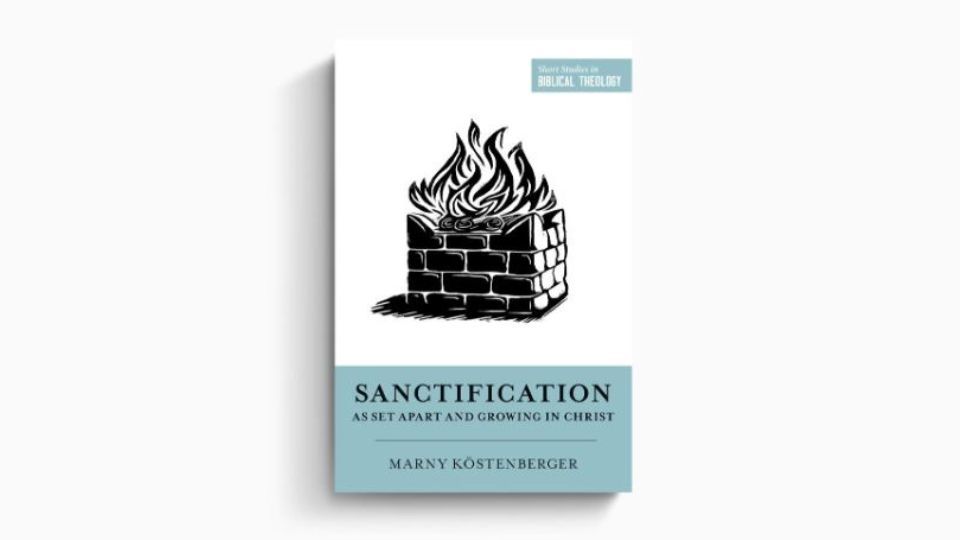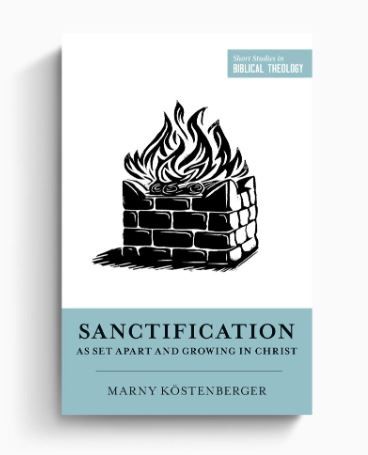Sanctification as Set Apart and Growing in Christ
Sanctification as Set Apart and Growing in Christ is a book that guides the reader through the Bible and what it teaches about sanctification.

Sanctification as Set Apart and Growing in Christ is written by Marny Köstenberger (ThD, University of South Africa) and published by Crossway as a part of the Short Studies in Biblical Theology. This book takes the theme of Sanctification and traces it through the entire storyline of the Bible.
1. Clarifying the Confusion Regarding the Nature of Sanctification
The purpose of this book is to bridge "the sanctification gap — the chasm between people's best intentions and their inadequate understanding of what the Scriptures teach on sanctification." Our Reformed Christian heritage has focused primarily on justification at conversion, and less is written and discussed on sanctification, character growth, and spiritual development.
2. Content of Sanctification as Set Apart and Growing in Christ
Introduction
In her introduction to the book, Kostenberger lists several reasons for this "sanctification gap."
- Language Gap - The translation of the Greek term for "holiness" (hagiasmos) and "holy" (hagios) with sanctificatio and sanctus in the Latin Vulgate could wrongly suggest that "saints" are Christians who meet special qualifications for holiness.
- Tradition Gap - Different traditions offer different views on the doctrine of sanctification.
- Relevance Gap - Many people today do not care about holiness.
The Old Testament
Chapter one surveys the language and theme of sanctification in the Old Testament.
- Sanctification is most commonly expressed in the OT through the qadosh word group. This word group contrasts what is holy (withheld from ordinary use) with what is common or profane.
- Holiness is one of the attibutes of God. (Isa 6:1–4)
- When God created man in His image, holiness is God's gift to the people he has made. Sin destroyed man's ability to fulfill his "divinely ordained callings."
- Israel, God's covenant people, expressed their holiness through their devotion and keeping of the Levitical Code (God's standard of holiness).
- God continuously worked to restore Israel from the time of the Judges through the Babylonian Exile.
- Through the tabernacle and temple, God manifested His presence and holiness.
- Because man failed to keep God's series of covenants, God articulated through Jeremiah and Ezekiel a New Covenant.
- In summary, the Old Testament depicted the holiness of God and His expectation that His covenant people live holy lives.
The Four Gospels
Chapter two follows the theme of sanctification in the four Gospels focusing specifically on the Sermon on the Mount (Matthew 5–7) and Jesus' Farewell Discourse (John 13–17).
- "The holy God visited his chosen people in the incarnation of Jesus, who walked in perfect human holiness."
- In the New Testament, the adjective hagios is the primary word translated "holy" and is used to describe people, things, places, Scripture, and Spirit.
- Hagiazo means "to make holy" or "to sanctify." (Jn 17:17; 1 Pet 3:15)
- Four Greek words fall into the NT concept of sanctification: (1) arete "goodness, moral excellence", hagios "holy", teleios "perfect, mature behavior", and pneumatikos "spiritual".
- Jesus taught that He is the greater Moses whose ethical teaching exceeds that given in the Old Testament law.
- Jesus's body is depicted in the gospel of John as the new temple (John 2:18–21; 4:19–24).
- Jesus called his covenant people to be holy. (Jn 10:36; 17:19)
Acts and the Early Epistles
Chapter three reviews the teachings about sanctification from the book of Acts and early NT epistles.
- Those who put their trust in Jesus Christ and His resurrection were "sanctified, set apart for God and his holy use."
- James stated that those who walk in holiness must "be doers of the word, and not hearers only. (James 1:23)
- In Galatians, Paul wrote that believers are to "walk in the Spirit" and "live by the Spirit."
- Paul exhorted the Thessalonians to pursue sanctification and abstain from sexual immorality.
More from Paul's Epistles
Chapter four continues tracing the theme of sanctification in Romans, Corinthians, and Ephesians.
- Paul's frequent use of the phrase "in Christ" alludes to the reality that believers are united with Christ, participate in the life of Christ, and receive imputed righteousness and God's Spirit given by Christ.
- Even though the Corinthians were not close to being perfect, Paul called them "those sanctified in Christ." (1 Cor 1:2)
- Romans 6–8 teaches that we need to "present our bodies to God as instruments of righteousness, which involves a deliberate, conscious choice to serve God in the power of the Spirit rather than succumb to our sinful nature."
- Paul taught in Ephesians that the church is a spiritual temple comprised of both Jews and Gentiles who form the church and God's dwelling place by the Spirit.
Hebrews and 1 Peter
Chapter five reviews teachings about sanctification and suffering found in Hebrews and 1 Peter.
- Virtually the entire book of Hebrews is devoted to the topic of sanctification.
- Jesus' sacrifice gives believers access to God and his holiness.
- Jesus is "both the author and perfecter of faith and as the forerunner who has already entered heaven, the perfect sanctuary."
- We can look to those who lived before us to encourage us in our struggle against sin.
- In 1 Peter, believers are reminded they are resident aliens in this world, and they are to be set apart as holy.
Later New Testament Writings
Chapter six concludes the survey of the Bible and the theme of sanctification focuses on the later NT writings.
- Paul urged Timothy to "set the example of godliness for all believers" and instructed mature belivers to mentor those who are younger.
- Jude's doxology affirms that God keeps believers from stumbling and will present them *blameless."
- 2 Peter spotlights "Christian character (being) rather than merely engaging in various Christian activities (doing)."
- John uses the phrase "walking in the light" while acknowledging that believers still sin. "Vertical call to holiness manifests itself in horizontal relationships."
- Our final sanctification is described in the book of Revelation when all believers will received glorified bodies and the presence of evil will be removed.
Putting It All Together
Chapter seven synthesizes the observations found in the first six chapters and provides implications and applications.
- Christ's death and resurrection makes it possible for Christians to pursue a new way of life, holy living.
- Believers are united with Christ, participants in Christ's death and resurrection, which provides the basis for the Holy Spirit's work of positional sanctification and progressive sanctification.
- Sanctification is a sovereign work of God, but it also involves dedicated participation by the believer.
- God's process of sanctification involves discipline and suffering.
- Sanctification involves the church, a community of like-minded believers under the leadership of qualified elders.
- Sanctification resides in the sphere of marriage and the family. (Eph 5:21–29)
In Christ, believers are positionally sanctified through the gift of the indwelling Holy Spirit and empowered to work out their salvation in progressive sanctification, propelled toward moral excellence, missional community, and menaingful relationships.
3. Commentary on Sanctification as Set Apart and Growing in Christ
This book is an excellent, readable biblical theology on the doctrine of sanctification. From Genesis to Revelation, Köstenberger succeeds in giving us a "historical, literary, and theological survey of sanctification." It seems appropriate that more space is reserved for what is taught in the New Testament, although I would have liked the author to have spent a little more effort in the details found in Leviticus since so much of the foundation of holiness and sanctification is found in the Pentateuch and the Levitical Code.
The organization of the content of the book, the chapters themselves and their subheadings, add to the book's clarity and readability. The bibliography for further studies and the included topical and scripture index are much welcomed.
For newer believers, I would begin my pursuit to understand sanctification by reading a chapter on sanctification from a readable systematic theology. Two recommended options include chapter 44 of Everyone's a Theologian or chapter 38 of Grudem's Systematic Theology. Once you have read a good overview from a systematic theology, adding to your knowledge through this biblical theology on sanctification.
4. Final Thoughts
Sanctification as Set Apart and Growing in Christ is an excellent Bible survey from Genesis to Revelation on the topic of sanctification. It is readable for everyday Christians, and it will also serve well pastors and Bible teachers who want a guided tour of the Bible on this important topic.

Sanctification as Set Apart and Growing in Christ
Written by Marny Köstenberger | Crossway (2023)




